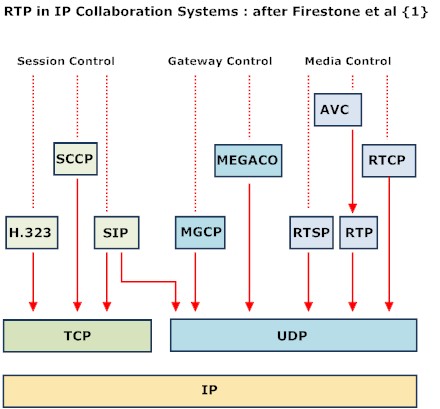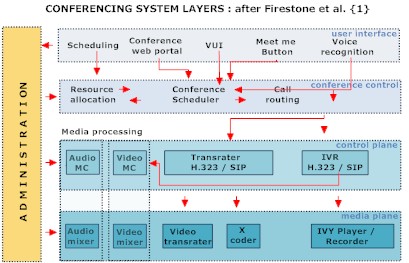 Section
Navigation
Section
Navigation
7. Technical Aspects
:Fundamental
7.1 Anatomy of Internet
7.2 Telecommunications
7.3 Wireless systems
7.4 Client Computers
7.5 Mobile Devices
7.6 Operating Systems
7.7 Computer Programs
7.8 Security: Applications
7.9 Browsers
7.10 Business Intelligence Systems
7.11 Cloud Computing
7.12 Databases
7.13 DTP Programs
7.14 eBook Readers
7.15 eMail Services
7.16 Expert Systems
7.17 Graphics Programs
7.18 Internet TV
7.19 Music & Video
7.20 Really Simple Syndication
7.21 Rich Media
7.22 Search Engines
7.23 Spreadsheets
7.24 Video Conferencing
7.25 Word Processing
:Corporate Matters
7.26 Cluster Analysis
7.27 Neural Networks
7.28 Pricing Models
7.29 Realtime Systems
7.30 Regression Analysis
 7.24
Video Conferencing
7.24
Video Conferencing
Web conferencing enables a company to conduct live
meetings, training, or presentations via the Internet. Each participant
sits at his or her own computer and is connected to other participants
by one of two methods. Either they install downloaded software, or they
enter a predistributed password to access a meeting held on 'third-party
premises'.
Web conferencing is increasingly used by companies of all sizes, and offers:
1. More efficient and effective meetings.
2. Reduced or zero travel time and cost.
3. Better communication with customers, partners and vendors.
4. Reduced sales cycle time and costs.
5. Improved technical support and customer service.
6. Better follow up on staff training.
Types
Video conferencing employs voice over IP (VoIP) technology and is of three types:
1. Ad hoc conferencing: set up over the telephone. The person hosting the conference calls an attendee, presses the Conference button, and a one-to-one telephone call is expanded to accept other participants, who are then called by the meeting host. The Meet Me model is similar but uses specially designated telephone numbers. Administrators set up these numbers by configuring the local phone system to forward calls to a conference server. Once in operation, the conference server manages calls independently of the larger telephone system. All who have the designated numbers can join the conference, but are commonly asked to identify themselves.
2. Reservationless: still fairly basic and commonly set up with the telephone keypad. Here the meeting organizer specifies a meeting name and creates a meeting identifier. The person hosting the meeting generally dials into the conferencing system and creates a meeting instance via the Interactive Voice Response (IVR) system.
3. Scheduled conferences: offers the fullest facilities and is set up in advance, at times mutually convenient to attendees and when the Internet lines are not likely to be too congested. Meetings are arranged through the Internet ( web browser), the telephone, or are integrated with email and calendaring systems like Microsoft Outlook.
Practicalities
Video conferencing is straightforward to participants, and companies offer an easy-to-use service that is generally categorized under three endpoint options. {10} An endpoint option is a combination of camera, codec and screen. Codecs are coding and decoding programs.
1. Desktop video conferencing: a web-based, software-client-based,
and dedicated standalone video appliance or a video-enabled IP telephone
designed for the single user.
2. Room-based: employing one or more large screens and designed
for groups.
3. Telepresence: as 2. but including audio and visual enhancements
of furniture, sound and lighting arrangements to give participants the
feeling that they are sitting across the table from their colleagues.
Telepresence can also be used in areas hazardous to human beings. {9}
Several components are required:
1. Cameras and video conferencing codecs to encapsulate
and decapsulate video images at the endpoints,
2. Screens to display images,
3. Bridges, gateways and video conferencing multipoint control units
(MCUs) for interconnecting multiple endpoints, transcoding between different
codec encapsulations, interconnecting video conferencing systems with
other applications, policy and security enforcement, and external connectivity
across network boundaries,
4. Management tools to schedule of video conferencing sessions
and control session quality,
5. Data network resources to deliver video packets between endpoints
and other components.
Technicalities
Video conferencing employs complex technology, the details of which are the concern of engineers who set up the systems, and the technician who operate them. In outline, however:
VoIP
Voice over Internet Protocol enables calls to be made over a broadband Internet connection rather than a regular (or analog) phone line. VoIP is implemented using both proprietary and open protocols, and is a feature of various systems, particularly those of long distance telephone calls, video conferencing and Skype. The analog voice signal is digitized, encoded, divided into packets and sent as Internet Protocol (IP) packets over a packet-switched network. The same steps in reverse order convert the packets into audio signals at the receiving end. Video and data are handled separately, but in a similar way. Extra protocols are added for transmission in congested condition, and transmission made secure by various encryption methods (e.g. Secure IP, Secure Voice over IP and Secure Voice over Secure IP).
Audio and video information has to be compressed: there are several formats in common use. {4} {5}

Voice and video packets are sent under Realtime Transport Protocol (RTP) in which the following also play a part:
H 323 (handles call signaling and control, multimedia transport and
control, and bandwidth control)
SCCP (Signaling Connection Control Protocol)
SIP (Session Initiation Protocol)
MGCP (Media Gateway Control Protocol)
MEGACO (Media Gateway Control Protocol)
RTSP (Real Time Streaming Protocol)
AVC (Audio/Video Compression format)
RTCP (Real-Time Transport Control Protocol)
Conferencing System Components

Five components are needed:
1. User Interface, which itself consists of:
a. scheduler to arrange conferences in advance.
b. web portal accessed through a browser on
the client PC.
c. voice user interface (VUI) to manage participants.
d. a meet me or conference button on the telephone
keypad.
e. An interactive voice response (IVR) system
to deliver voice prompts to attendees.
2. Conference Control, which interacts with the User Interface and the scheduler to create meetings, insert and remove attendees, and connects them them to the IVR according to user input.
3. Control Plane, which contains the signaling stacks, controls incoming and outgoing connections, and negotiates the session parameters.
4. Media Plane, consisting of audio and video mixers, which have inputs and outputs for media streams.
5. Administrative Interface, which interacts with the four components above, and:
a. sets resource allocation defaults.
b. handles any overbookings.
c. specifies the maximum meeting length of time.
d. enables and defines the signal protocols.
e. configures the system name.
f. configures the audio preferences
g. configures the videocapabilities and bandwidth
limitations.
h. adds and configures system users and the
capabilities allowed.
i. adds or updates recorded prompts.
j. sets the system to an enabled or disabled
state.
Services
Some of the better-known services:
System |
Platform |
No. ofAttendees |
SecureAccess |
EncryptedMeetings |
Pricing |
Citrix
|
Windows& Mac |
<=15 |
yes |
no |
$49/month |
Cisco
|
PC, Mac, Linux,Unix, Solaris& iPhone |
<=25 |
yes |
no |
$49/month |
Adobe
|
PC, Mac, Linux,Unix, Solaris,& iPhone |
<=1500 |
yes |
no |
$45/host/monthor $0.32/user/minute |
Intercall
|
Windows & iPhone |
<=120 |
yes |
yes |
$59/host/monthor $0.17/user/minute |
Microsoft
|
Windows |
<=1250 |
yes |
no |
$16/user/month (prof)or $4.50/user/month
|
IBM
|
Windows,Mac & Linux |
<=2000 |
yes |
yes |
p.o.a. |
ZohoMeeting |
Windows |
<=100 |
yes |
yes |
from $12/month (5)to $49/month (100 users) |
DimDim |
Windows,Mac & Linux |
<=100 |
yes |
no |
$0-33/user/month |
Elluminate |
Windows,Mac & Linux |
50-400 |
no |
no |
$50/month |
AllConferencing |
Windows,Mac & Linux |
<=99 |
yes |
yes |
from $19/month |
BuddyMeeting |
Windows,Mac & Linux |
<=10 |
no |
no |
free |
FuzeMeeting |
Windows,Mac & Linux |
55+ |
no |
no |
$10-69/month |
Glance |
Windows,Mac & Linux |
100 |
no |
no |
$50/month |
NetViewer |
Windows,Mac & Linux |
<=200 |
no |
no |
$30/month |
omNoviaWebConference |
Windows,Mac & Linux |
2-5000 |
yes |
yes |
$40/month -$8.10/seat |
OpenMeetings |
Windows,Mac & Linux |
<=25 |
no |
no |
free |
Tokbox |
Windows& Mac |
20-25 |
- |
- |
free APIsfor developers |
VenueGen |
Windows |
<=500 |
no |
no |
$0-790/month |
WebEx |
Windows,Mac & Linux |
<=25 |
yes |
yes |
$49/month |
WebHuddle |
Windows,Mac & Linux |
small |
no |
no |
free while beta |
Yugma |
Windows,Mac & Linux |
<=500 |
no |
no |
$0/10 users/month to
|
 Questions
Questions
1. Why is video conferencing becoming an important aspect of business
life?
2. Describe the three types of video conference, and the three ways
it may be set up.
3. What components are required for video conferencing? Show how they
interact.
4. Give some account of Voice over Internet Protocol, and the other
protocols involved in video conferencing.
5. Consider three popular video conferencing services and compare their
features in detail.
 Sources
and Further Reading
Sources
and Further Reading
1. Voice and Video Conferencing Fundamentals
by Scott Firestone, Thiya Ramalingam and Steve Fry. Cisco Press. March
2007.
2. Voice Over Internet Protocol. Federal
Communications Commission. May 2009. Simple presentation and faqs.
3. Voice over Internet Protocol. Wikipedia.
More detailed and technical treatment.
4. Audio compression (data). Wikipedia.
Principles and introduction to coding methods.
5. Video compression. Wikipedia.
Introduction: theory and links to formats in common use.
6. Comparison of web conferencing software. AllConferencing.
Features compared.
7 Web conferencing and webinar solutions put to the test. Open
Meeting Tools Review. 35 services ranked.
8. Real-Time Web Conferencing. ThinkofIt.
Extensive listings: some a little dated but useful.
9. Telepresence.
What Is. A specialized form of video conferencing.
10. Video conferencing adoption: Tracking trends and deployment strategies
by Katherine Trost. SearchUnifiedCommunications.
September 2010.
11. Top Three Trends in Video Conferencing by Irwin Lazar. No
Jitter. May 2010.
12. Business videoconferencing poised for 2011 breakthrough by
Heather Clancy. SearchitChannel.
January 2011.
13. Top Five Reasons to Use Web-Based Video Conferencing. MegaMeeting.
Undated white paper.
14. The Video Conferencing Boom — Top Trends to Watch. OneStopClick.
September 2011.